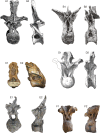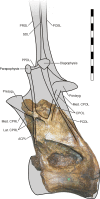Xenoposeidon is the earliest known rebbachisaurid sauropod dinosaur
- PMID: 30002991
- PMCID: PMC6037143
- DOI: 10.7717/peerj.5212
Xenoposeidon is the earliest known rebbachisaurid sauropod dinosaur
Abstract
Xenoposeidon proneneukos is a sauropod dinosaur from the Early Cretaceous Hastings Group of England. It is represented by a single partial dorsal vertebra, NHMUK PV R2095, which consists of the centrum and the base of a tall neural arch. Despite its fragmentary nature, it is recognisably distinct from all other sauropods, and is here diagnosed with five unique characters. One character previously considered unique is here recognised as shared with the rebbachisaurid diplodocoid Rebbachisaurus garasbae from the mid-Cretaceous of Morocco: an 'M'-shaped arrangement of laminae on the lateral face of the neural arch. Following the more completely preserved R. garasbae, these laminae are now interpreted as ACPL and lateral CPRL, which intersect anteriorly; and PCDL and CPOL, which intersect posteriorly. Similar arrangements are also seen in some other rebbachisaurid specimens (though not all, possibly due to serial variation), but never in non-rebbachisaurid sauropods. Xenoposeidon is therefore referred to Rebbachisauridae. Due to its inferred elevated parapophysis, the holotype vertebra is considered a mid-posterior dorsal despite its elongate centrum. Since Xenoposeidon is from the Berriasian-Valanginian (earliest Cretaceous) Ashdown Formation of the Wealden Supergroup of southern England, it is the earliest known rebbachisaurid by some 10 million years. Electronic 3D models were invaluable in determining Xenoposeidon's true affinities: descriptions of complex bones such as sauropod vertebrae should always provide them where possible.
Keywords: 3D modelling; Dinosauria; Laminae; Rebbachisauridae; Sauropoda; Wealden; Xenoposeidon.
Conflict of interest statement
The authors declare that they have no competing interests.
Figures







References
-
- Bonaparte JF. Les dinosaures (Carnosaures, Allosauridés, Sauropodes, Cétiosauridés) du Jurassique moyen de Cerro Cóndor (Chubut, Argentina) Annales de Paléontologie. 1986;72:325–386.
-
- Bonaparte JF. Evolucion de las vertebras presacras en Sauropodomorpha [Evolution of the presacral vertebrae in Sauropodomorpha] Ameghiniana. 1999;36(2):115–187.
-
- Borinder NH, Poropat SF, Kear BP. Reassessment of the earliest documented stegosaurian fossils from Asia. Cretaceous Research. 2016;68:61–69. doi: 10.1016/j.cretres.2016.08.004. - DOI
-
- Carballido JL, Rauhut OWM, Pol D, Salgado L. Osteology and phylogenetic relationships of Tehuelchesaurus benitezii (Dinosauria, Sauropoda) from the Upper Jurassic of Patagonia. Zoological Journal of the Linnean Society. 2011;163(2):605–662. doi: 10.1111/j.1096-3642.2011.00723.x. - DOI
Associated data
LinkOut - more resources
Full Text Sources
Other Literature Sources

